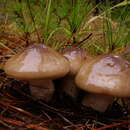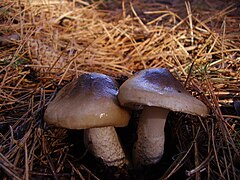mk
имиња во трошки


Guidance for identification
La llenega negra o mocosa negra (Hygrophorus latitabundus, del grec antic higrós: 'humit', phorós: 'portador'; del llatí latitabundus: 'molt amagat') és potser el bolet comestible més valorat i buscat a Catalunya, i especialment al Bages, Berguedà i Solsonès.
El capell, de 5-12 cm de diàmetre i amb el marge força enrotllat, és d'un color bru olivaci i llefiscós, produït per un mucílag transparent, molt abundant, que recobreix tant el barret com el peu cilíndric i robust. Amb làmines blanques, espaiades, decurrents i gruixudes.[1] Es pot prestar a confusió amb Cortinarius trivialis; la carn és de color blanca i compacta, d'una olor suau.
Es poden trobar en boscs mixtos, a les pinedes de pi blanc, pi roig, però, sobretot, a les de pinassa. Surt en terrenys calcaris.
És un bolet culinàriament excel·lent, molt apreciat a les comarques centrals del Bages, Berguedà i Solsonès. Ideal per fer estofats i guisats.
La llenega negra o mocosa negra (Hygrophorus latitabundus, del grec antic higrós: 'humit', phorós: 'portador'; del llatí latitabundus: 'molt amagat') és potser el bolet comestible més valorat i buscat a Catalunya, i especialment al Bages, Berguedà i Solsonès.
Der Große Kiefern-Schneckling (Hygrophorus latitabundus, Syn.: Hygrophorus fuscoalbus (Lasch Fr.))[1] ist ein Pilz aus der Familie der Schnecklingsverwandten (Hygrophoraceae). Der seltene Schneckling kommt in Kiefernwäldern vor und hat eine Vorliebe für kalkhaltige Böden. Die großen und kräftigen Fruchtkörper sind essbar und erscheinen im Herbst. Der blass graubraune bis dunkel olivbraune Hut ist bei Feuchtigkeit sehr schleimig. Andere Namen für diesen Pilz sind Weißschuppiggestiefelter- oder Grauweißer Schneckling. Das lateinische Artepitheton latitabundus bedeutet „sich versteckt haltend“.
Die Fruchtkörper des Schnecklings sind groß und kräftig und vollständig von einer Schleimschicht überzogen. Der Hut ist 5–15 cm breit, zuerst gewölbt und später fast ausgebreitet bis leicht trichterförmig vertieft. In der Mitte ist er meist stumpf gebuckelt. Die Hutfarbe ist blass fleckig graubraun bis olivbraun, in der Mitte dunkler als am helleren Rand. Charakteristisch ist die schleimig glänzende, glatte Huthaut, besonders bei feuchter Witterung. Bei Trockenheit ist die Huthaut eher matt. Der Hutrand bleibt lange Zeit eingerollt und ist später heruntergebogen.
Die weißen, entfernt stehenden Lamellen sind dick, wachsartig und am Stiel breit angewachsen oder laufen leicht daran herab. Sie sind weißlich bis blass cremefarben und häufig mit Zwischenlamellen untermischt. Die Lamellenschneiden sind glatt.
Der weiße Stiel ist etwa 5–10 cm lang und 2–4 cm dick. Er ist zylindrisch bis bauchig geformt und voll und festfleischig. Er wird von einer dicken Schleimschicht bedeckt. Im oberen Drittel ist eine deutliche Ringzone erkennbar. Oberhalb des Ringes ist er weiß und mit weißen Flöckchen bedeckt, unterhalb des Rings ist er sehr schleimig und olivbraun genattert. Die Stielbasis ist oft zugespitzt.
Das weiße Fleisch ist fest, riecht schwach aromatisch und schmeckt angenehm mild und fade. Tropft man etwas Ammoniaklösung auf das Stielfleisch, verfärbt es sich an der Stielbasis orange bis rostrot und dann braun und an der Stielspitze gelbocker. Mit 30-prozentiger Kalilauge verfärbt sich das Stielfleisch gelb.
Das Sporenpulver ist weißlich, die elliptischen Sporen selbst sind 8–12 µm lang und 6–8 µm breit und hyalin. Die Hyphen der Huthaut enthalten nur intrazelluläres Pigment, teilweise sind sie mit öligen Exsudatbatzen besetzt.[2][3][4][5]
Unter den vielen Arten der Gattung Hygrophorus sind einige, die mit dem Großen Kiefern-Schneckling verwechselt werden können.
Der große Kiefern-Schneckling ist ein Mykorrhizapilz, der fast ausschließlich mit Kiefern (Pinus) eine symbiotische Beziehung eingeht. Man findet den Pilz daher in lichten, grasigen Wäldern oder Kiefernforsten, an Waldrändern, auf Wacholder-Kiefern-Heiden und auf basenreichen Halbtrockenrasen. Der Schneckling mag flachgründige, etwas verdichtete, warme, mäßig trockene bis frische, basische und relativ nährstoffarme Böden über Kalk oder Kalkmergel.
Die Fruchtkörper erscheinen truppweise im Spätsommer bis Herbst. Es ist eine seltene Art, doch dort, wo sie vorkommt, kann sie durchaus häufiger sein.[2][7][8][7]
Der Schneckling ist eine holarktische, submeridionale temperat bis subboreale Art, die in Nordamerika (USA, Kanada) und Europa vorkommt. Sein Verbreitungsgebiet erstreckt sich über Süd- und Mitteleuropa. Er wurde bisher auf den Balearen, in Spanien, Frankreich, Italien, der Schweiz, Liechtenstein, Österreich, Deutschland, Belgien, Tschechien, Slowenien, Polen und Weißrussland nachgewiesen. Er kommt aber auch in der Republik Mazedonien, in Griechenland und der Türkei vor.[9][10][11]
In Deutschland ist er vor allem im süd- und mitteldeutschen Berg- und Hügelland verbreitet. Der Schneckling fehlt in Hessen, Sachsen, Brandenburg, Mecklenburg-Vorpommern und Schleswig-Holstein. In Niedersachsen ist er sehr selten.[4][7][12]
Der Große Kiefern-Schneckling wird in die Sektion Olivaceoumbrini gestellt. Die Vertreter der Sektion haben schmierige bis schleimige Hüte und Stiele. Ihre Hüte sind dunkel braungrau, oliv oder orange. Der Stiel ist genattert oder mehr oder weniger deutlich beringt.
Der Große Kiefern-Schneckling gilt als guter Speisepilz, die Huthaut sollte allerdings abgezogen werden.[4][5] In Spanien wird er häufig gesammelt und auch auf Märkten verkauft.[13][14] In Deutschland sollte er wegen seiner starken Gefährdung (RL2) besser nicht gesammelt werden.
In der Volksmedizin Kataloniens wird der Schneckling, der dort Mocosa negra, also „Schwarze Rotznase“ genannt wird, bei Darmerkrankungen, Durchfall und Magengeschwüren eingesetzt. Dabei wird der Pilz im abgekochten Zustand, meist in Form einer Suppe, verabreicht.[15]
Der Große Kiefern-Schneckling (Hygrophorus latitabundus, Syn.: Hygrophorus fuscoalbus (Lasch Fr.)) ist ein Pilz aus der Familie der Schnecklingsverwandten (Hygrophoraceae). Der seltene Schneckling kommt in Kiefernwäldern vor und hat eine Vorliebe für kalkhaltige Böden. Die großen und kräftigen Fruchtkörper sind essbar und erscheinen im Herbst. Der blass graubraune bis dunkel olivbraune Hut ist bei Feuchtigkeit sehr schleimig. Andere Namen für diesen Pilz sind Weißschuppiggestiefelter- oder Grauweißer Schneckling. Das lateinische Artepitheton latitabundus bedeutet „sich versteckt haltend“.
Hygrophorus latitabundus is a species of fungus in the genus Hygrophorus. It is distributed in European pine forests, and has a preference for calcareous soils. It fruits in autumn, producing large, edible mushrooms with slimy caps and stems.
Hygrophorus latitabundus fruiting bodies are large agarics. The cap is convex and slightly umbonate, coloured grey, brown and olivaceous with a darker, brownish centre. It is characteristically covered by a glutinous layer of slime, especially in wet weather conditions. The margin is inrolled. The cap diameter can reach 15 cm, and as it matures, it flattens out. The white gills are thick, distant and have an adnate to weakly decurrent attachment to the stem.
The white stem is tall, fusiform, thick and robust. It is ornamented by numerous whitish flakes which are covered in a thick layer of slime. The flakes have a tendency to become brown. The flakes and slime extend from the base of the stem to the level of the margin, where they stop abruptly, creating a ring-like zone. Above this, the stem is white and visibly thinner. The stem is up to 15 cm tall and 2–4 cm thick.
The white flesh is thick and firm, with a fungal smell and pleasant taste. An identification aid is the chemical reaction of the stem flesh when exposed to ammonia solution. In this species, it turns orange-rust and then brown in the base and yellow-ochre at the top.[2][3][4][5]
Hygrophorus latitabundus is reported to be a good, edible fungus.[3][4] It is collected and marketed for consumption in Spain, particularly in the Catalan region, where it is known as llenega negra.[6][7]
Hygrophorus latitabundus is found in coniferous forests, forming ectomycorrhizal relationships exclusively with pines (Pinus). The fungus fruits in autumn and shows a preference for calcareous soils. Its occurrence is rare, though it is abundant there where it is established.[8]
Its distribution encompasses southern and central Europe, including Austria, Germany, France, Italy, Slovenia and Spain.[3][9] It is also known to occur in the Republic of Macedonia, Greece and Turkey.[10][11][12]
Among the many species of the genus Hygrophorus, there are some which can be mistaken for Hygrophorus latitabundus.
{{cite journal}}: Cite journal requires |journal= (help) ![]() Media related to Hygrophorus latitabundus at Wikimedia Commons
Media related to Hygrophorus latitabundus at Wikimedia Commons
Hygrophorus latitabundus is a species of fungus in the genus Hygrophorus. It is distributed in European pine forests, and has a preference for calcareous soils. It fruits in autumn, producing large, edible mushrooms with slimy caps and stems.
Capel fin a 16 cm, motobin a pupa, tachiss, bistr bronzà con ël bòrd anrolà pì ciàir. Lamele bianche peui crema òcra. Gamba àuta fin a 16 cm e larga fin a 5 cm, a fus pansarùa un pòch radicanta, bianca con striadure tachisse ch'a ven-o gris bistr olivastr sota a na linia bin precisa. Carn bianca.
A chërs sota ij pin.
![]() A venta mai mangé un bolè trovà se un a l'é nen un bon conossidor dij bolè!
A venta mai mangé un bolè trovà se un a l'é nen un bon conossidor dij bolè!
Mangiativ.
Capel fin a 16 cm, motobin a pupa, tachiss, bistr bronzà con ël bòrd anrolà pì ciàir. Lamele bianche peui crema òcra. Gamba àuta fin a 16 cm e larga fin a 5 cm, a fus pansarùa un pòch radicanta, bianca con striadure tachisse ch'a ven-o gris bistr olivastr sota a na linia bin precisa. Carn bianca.
AmbientA chërs sota ij pin.
Comestibilità![]() A venta mai mangé un bolè trovà se un a l'é nen un bon conossidor dij bolè!
A venta mai mangé un bolè trovà se un a l'é nen un bon conossidor dij bolè!
Mangiativ.
Wodnicha brunatnobiała (Hygrophorus latitabundus Britzelm) – gatunek grzybów z rodziny wodnichowtych (Hygrophoraceae)[1].
Pozycja w klasyfikacji według Index Fungorum: Hygrophoraceae, Agaricales, Agaricomycetidae, Agaricomycetes, Agaricomycotina, Basidiomycota, Fungi [1].
Niektóre synonimy naukowe[2]:
Nazwę polską podała Barbara Gumińska w 1997 r[3].
Średnica od 4 do 12 cm, półkulisty, wypukły do płasko wypukłego, u starszych okazów również nieco lejkowaty, z długo podwiniętym brzegiem, tępym płaskim garbkiem, gładki, bardzo oślizgły (często z warstwą śluzu), szarobrązowy, rdzawobrązowy, o oliwkowym odcieniu, pośrodku ciemniejszy[4].
Do trzonu szeroko przyrośnięte lub łagodnie zbiegające, grube, rzadkie, szerokie. Są białawe, o prostych ostrzach[4].
Wysokość od 5 do 10 cm, średnica od 1,5 do 4 cm, cylindryczny do wrzecionowatego, zaostrzony u dołu, pełny, zwarty. Powierzchnia bardzo oślizgła, kosmkowato-łuseczkowata, biaława, po uciśnięciu ciemnieje. Pierścień występuje tylko u bardzo młodych okazów, szybko zanika[4].
Gruby, gęsty i wodniście biały. Ma słaby zapach gorzkich migdałów, w smaku jest łagodny[4].
Wodnicha brunatnobiała znana jest tylko w niektórych krajach Europy[5]. W piśmiennictwie naukowym do 2003 r. na terenie Polski podano tylko 2 jej stanowiska[3]. Od 2014 r. w Polsce jest objęta ochroną częściową grzybów[6].
Pojawia się od września do listopada pod sosnami, w nasłonecznionych miejscach, zwłaszcza na [wapieniach, w strefie podgórskiej i górskiej[4].
Grzyb mikoryzowy[3]. Smaczny grzyb jadalny, do przyrządzania potraw do bezpośredniego spożycia lub marynowania w słodko – kwaśnej zalewie[7]. W Polsce podlega ochronie prawnej.
Minimalna możliwość pomylenia z podobnymi gatunkami. Charakterystycznymi cechami tego grzyba są: stosunkowo duży owocnik, bardzo oślizły kapelusz i trzon, podwinięty brzeg kapelusza i występowanie pod sosną. Nieco podobna jest wodnicha oliwkowobrązowa (Hygrophorus persoonii) i wodnicha oliwkowobiała (Hygrophorus olivaceoalbus)[4]. Można je rozróżnić reakcjami chemicznymi[8]:


Wodnicha brunatnobiała (Hygrophorus latitabundus Britzelm) – gatunek grzybów z rodziny wodnichowtych (Hygrophoraceae).